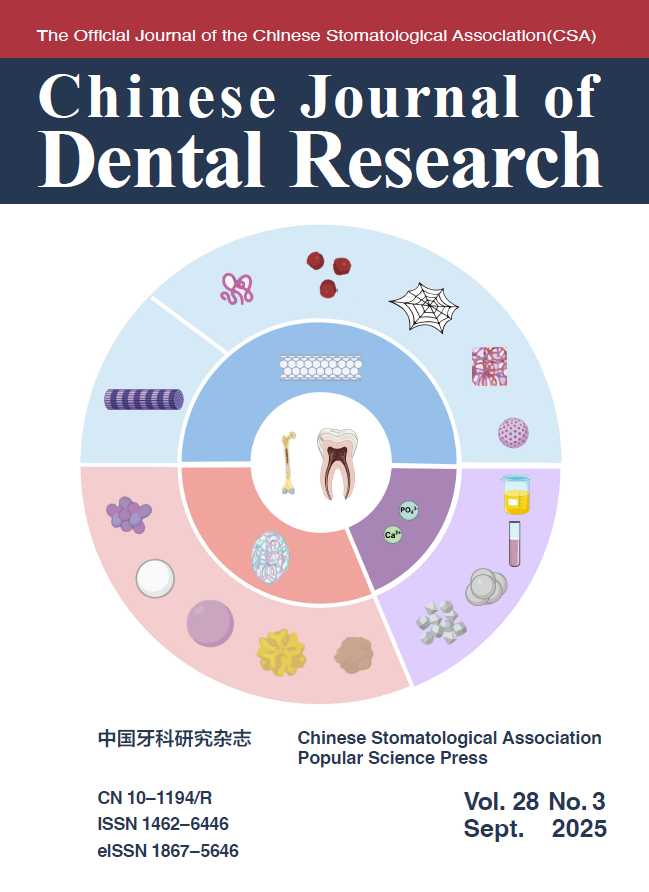- Chin J Dent Res
CN 10-1194/R . ISSN 1462-6446 . eISSN 1867-5646 . Quarterly 



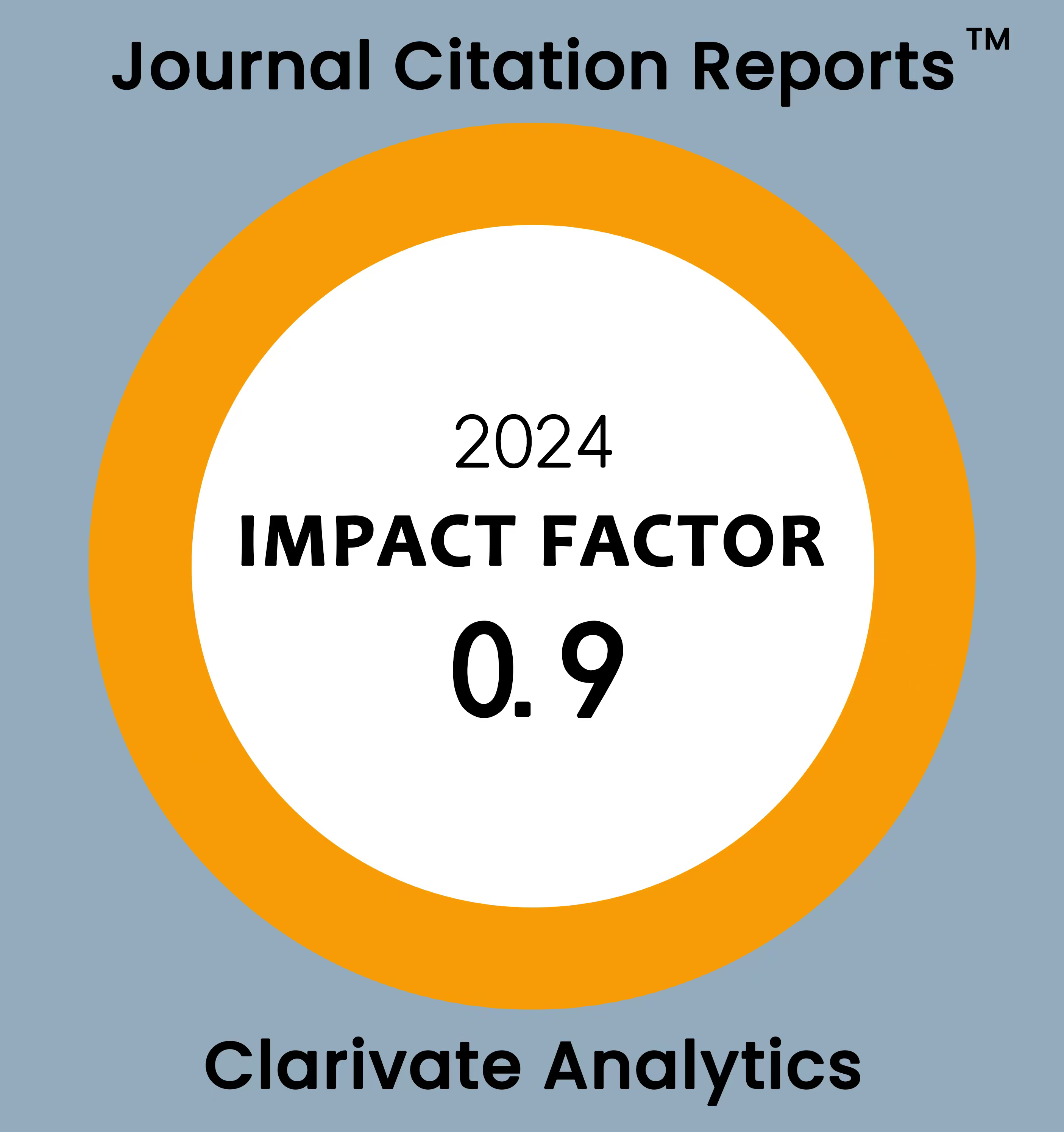
Jun 25,2025
According to the 2024 Journal Citation Reports™, the 2024 Impact Factor (IF) of the Chinese Journal of Dental Research (CJDR; CN 10-1194/R; ISSN 1462-6446; eISSN 1867-5646) is 0.9.
Published: 2024-06-18
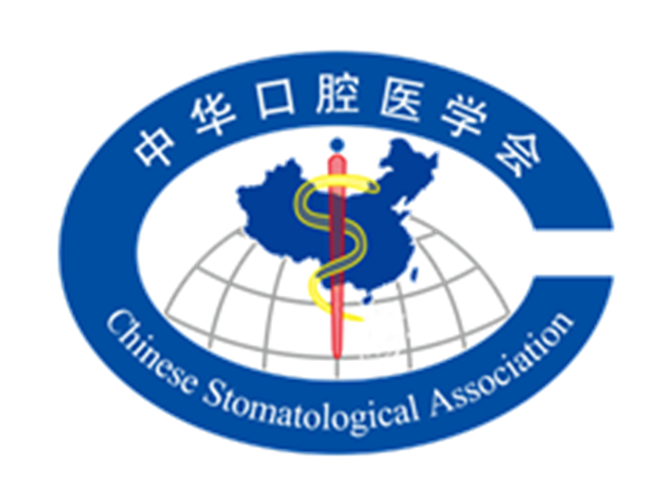
Apr 15,2024
The theme of the academic annual conferences held by the Chinese Stomatological Association from 2021 to 2023 was “Protecting Natural Teeth to Maintain Oral Health” and coincided with the 24th Winter Olympic Games that took place in Beijing in 2022, and thus prevention of oral and maxillofacial trauma once again attracted the attention of stomatological experts and the public. The incidence of oral and maxillofacial trauma caused by sports is around 25% to 34%1-5, and varies based on the type of sport and other factors, such as age, sex and the skill level of the participants. The risk of oral and maxillofacial trauma is extremely high in high-confrontation and high-speed sports, especially for children and adolescents. Wearing sports mouthguards when participating in sport is an effective way to prevent and reduce the incidence of oral and maxillofacial trauma in such sports, and is the simplest and most practical method of doing so. Sports have developed and gained in popularity significantly in China in recent years, but the awareness and use of sports mouthguards are low. Based on the above background, the Chinese Stomatological Association advocates that athletes and sport participants should wear mouthguards in various confrontational and high-speed sports, and calls on dental practitioners and sports-related organisations to actively support the popularisation and application of sports mouthguards to prevent or alleviate oral and maxillofacial trauma and to raise awareness and increase knowledge of methods to protect natural teeth.
Read More

Apr 15,2024
Oral health is an important component of general health, and oral disease is one of the most common human diseases that not only affects oral health and quality of life, but is also closely associated with overall health. Natural teeth are important functional organs and are crucial to oral functions and maintaining a healthy life. The Chinese Stomatological Association (CSA) has released this position statement on “Preserving Natural Teeth to Maintain Oral Health”, which is one of the most important achievements of the 2021 to 2023 CSA Annual Congress themed “Healthy Mouth, Protecting Natural Teeth”, advocating that everyone should take effective measures to protect their natural teeth, maintain oral health and promote general health.
Read More

Feb 21,2024
Oral submucous fibrosis (OSF) is a chronic, progressive and potentially malignant oral mucosal disease. Patients often have a habit of chewing betel nuts. Areca catechu has been listed as a Class 1 carcinogen by the International Agency for Research on Cancer (IARC), and its main active component, arecoline, is classified as a Group 2B carcinogen by the IARC. The World Health Organization (WHO) categorises OSF as an oral potentially malignant disorder (OPMD). The present guideline describes the risk factors, clinical symptoms and clinical signs of OSF. Clinical staging, auxiliary examination methods, basis for diagnosis and differential diagnosis and the need to improve bad lifestyle habits are proposed and addressed, and local treatment drugs, therapies, dosage and course of treatment, possible adverse reactions, and oral treatment drugs, dosage and course of treatment are proposed. The guideline also addresses the indications for surgical treatment, alternative non–drug treatment methods, selection of treatment plans for different clinical stages, criteria for efficacy evaluation, and preventive measures.
Key words: carcinogenic, chewing betel nut, oral potentially malignant disorders, oral submucous fibrosis, risk factors
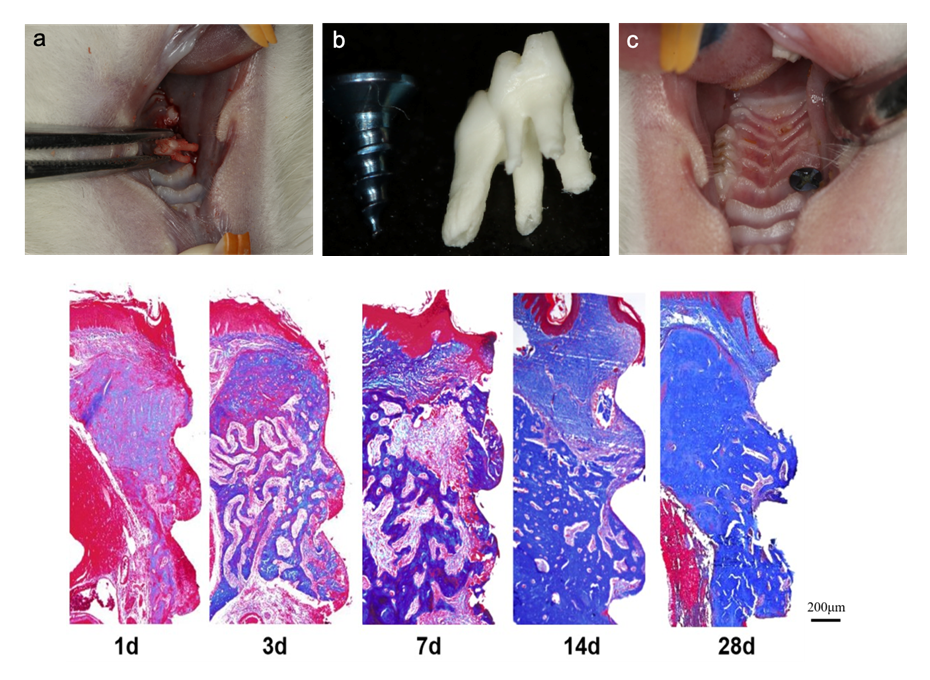
Oct 31,2022
Objective: To investigate the synergistic changes of the astrocytes and neurons in the sensorimotor cortex during the process of implant osseointegration after insertion.
Methods: A total of 75 rats were allocated into three groups (n = 25): non-operated, extraction and implant. The rats in the latter two groups underwent extraction surgery of three maxillary right molars. One month later, the implant group received one titanium implant in the healed extraction socket. The rats were sacrificed on days 1, 3, 7, 14 and 28 after implantation. The brain sections, including sensory centre S1 and motor centre M1, were selected for further immunofluorescence for measurement of the synergistic morphological and quantitative
changes of astrocytes and neurons.
Results: In layer IV of S1, the number of astrocytes in the implant group showed a descending trend with time; on days 1, 3, 7 and 14, the number of astrocytes in both the extraction group and the implant group was significantly higher than that in the non-operated group, and there was no difference between the extraction group and the implant group; however, on day 28, the number of astrocytes in the implant group was significantly lower than that in the extraction group. In layer V of M1, on days 7, 14 and 28, the number of astrocytes in the implant group was significantly lower than that in the extraction group; on days 14 and 28, the number of astrocytes in the extraction group was significantly higher than that in the non-operated group. In layer IV of S1 or layer V of M1, the number of neurons showed no significant changes between the three groups.
Conclusion: The astrocytes in the face sensorimotor cortex were activated as a reaction to oral environment changes. This kind of neuroplasticity can be reversed by oral rehabilitation with dental implants. The motor cortex may be intimately related to osseointegration and osseoperception.
Key words: motor cortex, neuroplasticity, oral implant, osseointegration, sensory cortexRead More
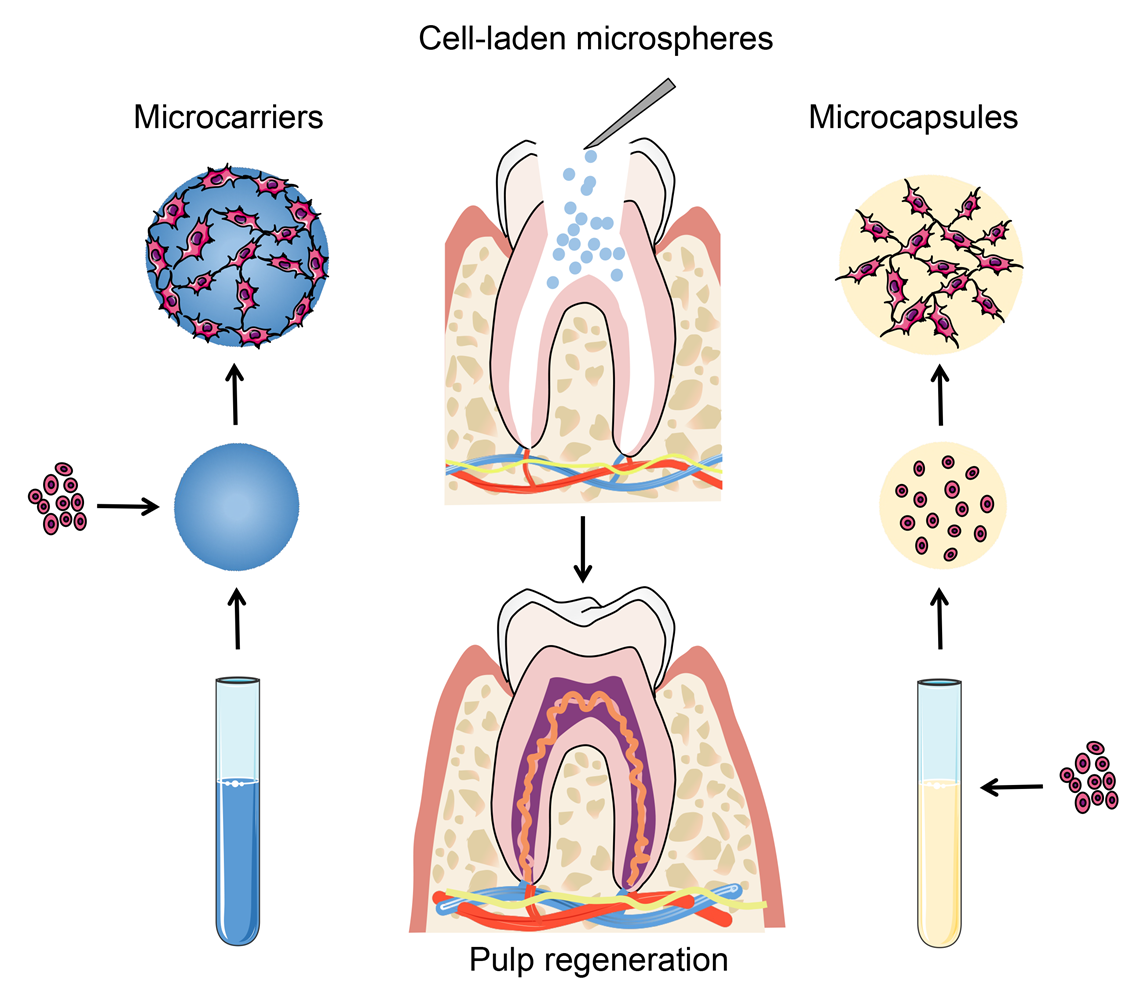
Mar 22,2022
Microspheres have been widely utilised as versatile carriers in biomedical applications. In recent years, as a new type of injectable scaffold, microspheres have attracted increasing attention in the field of regenerative medicine owing to their various advantages including their small size, large specific surface area and mimicry of the 3D native environment. These characteristics enable them to adopt the narrow and irregular anatomy of the tooth and
become an ideal scaffold for endodontic regeneration. Microspheres play an important role in carrying biologics (cells, biomolecules and drugs), which effectively regulate the fate of stem cells and control the release of growth factors and drugs. Cell-laden microspheres, which can be divided into microcarriers and microcapsules, have great application prospects in dental pulp regeneration. This paper summarises the properties and characteristics of microsphere scaffolds used in tissue engineering, placing emphasis on their advantages and applications in endodontic regeneration.
Key words: dental pulp, endodontic regeneration, microcapsules, microcarriers, microspheresRead More
The regeneration of oral maxillofacial hard tissues is currently one of the issues of most concern in public health. This complex process involves a variety of cell types residing in a specialized microenvironment known as the adult stem cell niche in living organisms. Within this niche, adult stem cells are considered to play a central role in the regeneration of hard tissues, which undergo rapid proliferation and differentiation into progenitor cells to replace lost tissue, throughout postnatal life. Their fate is tightly regulated by the niche factors secreted by the nonstem niche cells present within the same microenvironment. Over the past decades, the advent of lineage tracing techniques has revolutionised the in vivo study of cell dynamics. Through tissue- and temporally-specific labelling of Cre-expressing cells, this method enables researchers to depict the defined cell fates and differentiation trajectories. The present review summarises the progress made in lineage tracing studies of hard tissue formation cell populations residing in the oral and maxillofacial regions, with a focus on stem cells, progenitor cells and niche cells. The aim is to provide new clues for future research endeavours.
Keywords: adult stem cell niche, hard tissue formation, lineage tracing, niche cell, oral maxillofacial region, progenitor cell, stem cell
Objective: To assess the impact of incorporating various weight fractions of nanometre-sized particulate fillers on specific properties of microfilled composite resin.
Methods: Microfilled composite resin was prepared by mixing 29 wt.% of resin matrix (Bis- GMA/TEGDMA) with the 71 wt.% of silane treated particulate fillers (Ø 0.4 μm). Then, various fractions of nanometre-sized (180 nm) fillers (0, 5, 10, 15, 20, 25, 30 and 35 wt.%) were added gradually using a high-speed mixing machine. For each composite resin, flexural properties (n = 8) were evaluated using a three-point bending test on a universal testing machine (ISO standard 4049). Fourier transform infrared (FTIR)-spectrometry was used to calculate the degree of monomer conversion (DC%). Surface microhardess (Vickers) was also determined. Surface gloss was measured before and after polishing (4,000-grit paper). A two-body wear test was performed in a ball-on-flat configuration using a chewing simulator with 15,000 cycles. A non-contact 3D optical profilometer was utilised to measure wear depth. An analysis of variance (ANOVA) was applied to interpret the results statistically, then a post hoc Tukey analysis was performed.
Results: ANOVA revealed that the fraction of nanofillers had a significant effect (P < 0.05) on flexural modulus, DC%, microhardness, gloss and wear depth. The group without nanofillers showed the highest DC% (56.6%), gloss after polishing (76.2 GU) and wear resistance (24.2 μm) values, whereas the group with 35 wt.% of nanofillers had the highest flexural modulus (9 GPa) and microhardness (70 VH).
Conclusion: It is beneficial to add nanofillers to microfilled composite resin; however, it is essential to assess the proportion ratio carefully. Optimising all the properties of composite resin at once with just one formulation is challenging.
Keywords: microfilled composite resin, nanofiller fractions, properties
Osteonecrosis involving the permanent tooth germ in primary dentition is a rare condition that can affect dental and maxillofacial development without correct intervention. This case report presents the successful recovery from drug-induced mandibular osteonecrosis involving the permanent tooth germ in a child. A healthy 4-year-old Chinese girl visited the clinic with an unhealed gingival wound and alveolar bone exposure of the missing primary molar area after 1-day arsenic trioxide sealing during pulp therapy. Radiographic examinations indicated inflammation and sequestrum formation in the jaw. The diagnosis was mandibular osteonecrosis. The treatment plans involved sequestrectomy without extended curettage and removal of the affected permanent tooth germ with systemic antibiotic therapy. A 6-year follow-up revealed no recurrence of the lesion or complications, a gradual increase in bone density of the osteonecrosis area and the development of adjacent permanent tooth germs. A conservative treatment regimen without extended curettage may be an option for young patients with jaw osteonecrosis.
Keywords: arsenic trioxide, deciduous teeth, osteonecrosis, sequestrectomy, tooth germ
Objective: To compare the sequential healing of maxillary sinuses grafted with two different xenogeneic bone substitutes processed at either a low (300°C) or high (1200ºC) temperature.
Methods: A sinus augmentation procedure was performed bilaterally in 20 rabbits and two different xenogeneic bone grafts were randomly used to fill the elevated spaces. Healing was studied after 2 and 10 weeks, in 10 rabbits during each period.
Results: After 2 weeks of healing, very small amounts of new bone were observed in both groups, and were mainly confined to close to the sinus bone walls and osteotomy edges. After 10 weeks of healing, new bone was found in all regions, with higher percentages in those close to the bone walls and to the osteotomy. In this period of healing, the proportion of new bone in the 300°C group was 20.0% ± 4.3%, and in the 1200ºC group it was 17.2% ± 4.3% (P = 0.162). In the 1200ºC group, translucent, dark fog-like shadows in regions of the grafts were hiding portions of new bone (interpenetrating bone network).
Conclusion: Both biomaterials provided conditions that allowed bone growth within the elevated space, confirming that both biomaterials are suitable to be used as a graft for sinus floor augmentation.
Key words: animal study, bone healing, histology, sinus floor augmentation, sinus membrane
Objective: To investigate the differences between temporomandibular articular fossa bone surface and the envelope surface of the mandibular condyle movement.
Methods: Thirty-four healthy adults underwent skull base and mandible scans using CBCT and performed mandibular border movement using the mandibular movement recording system. Landmarks of the fossa and tubercle were indicated and distance and angle parameters were measured on the 3D models reconstructed from the CBCT. The condyle movement envelope surfaces were formed according to models reconstructed from CBCT and the mandibular movement trajectory using computer simulation. The highest and lowest points of the envelope surface were indicated to create parameters. The data were analysed using a paired t test in SPSS (version 24.0, IBM, Armonk, NY, USA).
Results: The mandibular fossa bone surface was statistically different to the envelope surface for the height of the first peak of the envelope surface (3.280 ± 1.319 mm) and depth of the mandibular fossa (6.338 ± 2.389 mm) (the ratio was 51.75%), the height of the second peak of the envelope surface (1.463 ± 0.745 mm) and the height of the tubercle (2.000 ± 0.968 mm) (the ratio was 73.15%), and the downwards angle of the envelope surface (25.933 ± 7.539 degrees) and the posterior slope angle of the articular tubercle (35.059 ± 5.224 degrees) (the ratio was 73.97%).
Conclusion: The downwards angle of the envelope surface was statistically significantly smaller than the posterior slope angle of the articular tubercle, suggesting that the condyle movement is flatter than the mandibular fossa bone surface.
Key words: artificial fossa component, condyle movement, envelope surface, mandibular fossa bone surface, temporomandibular joint
